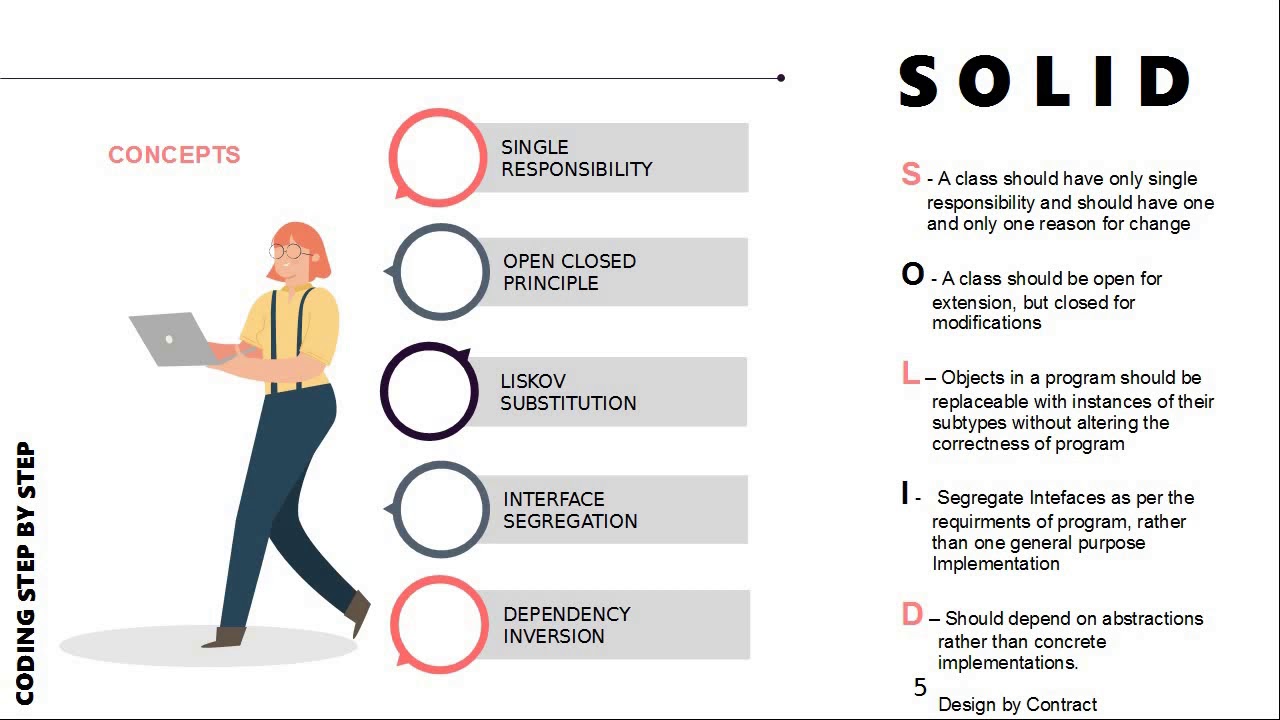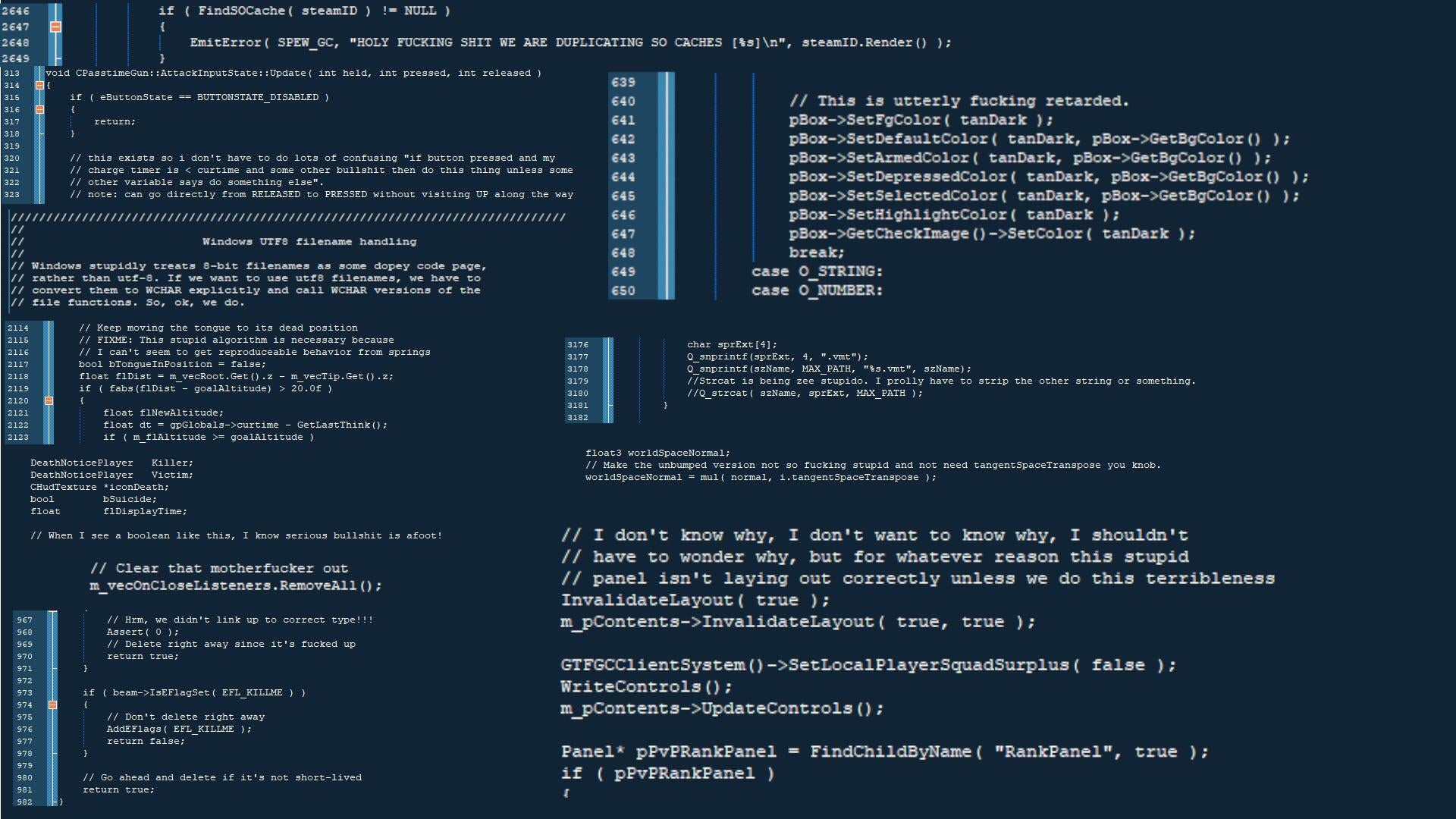SOLID Principle
What Is SOLID Principle
SOLID stands for five object-oriented design principles that together (when used with judgment) make your code more bug-proof, easier to understand, nicer to maintain, and simple to expand/scale.
- Single-responsibility Principle
- Open-closed Principle
- Liskov Substitution Principle
- Interface Segregation Principle
- Dependency Inversion Principle
Robert C. Martin designed the principles in his paper Design Principles and Design Patterns (link in Resources). Michael Feathers later created the catchy acronym. Let's look into what each principle means. To simplify them, you can read the coffee maker example provided in each subsection.
 Source: SOLID Principle
Source: SOLID Principle
Single-responsibility Principle
Martin describes it as: A class should have one, and only one, reason to change. You can understand it as A class should have a single reason to exist (or the job to do) More abstractly, things should specialize. It's better to have computeClass and outputerClass than do this in one class.
Example: Instead of having the coffee machine class that does everything, have a class for coffee grinding, coffee weighting, coffee brewing, and serving.
Open-closed Principle
Originally, it tells that Classes should be open for extension but closed for modification. What does it mean? If you want more functionalities in your class/modules/functions, add them instead of changing existing code. In the following example
class A ()
//makes coffe
else if(x.request == "tea"):
The else if violates the Open-closed Principle. If you want to add more functionalities in the future, you need to modify (add another if statement) the existing function and potentially create new bugs on the working product. Abstractly, if the new functionalities modify your already working code, you are creating more sunk costs.
Example: Do not rewrite already working function brewFrapucchino to (also) handle tea/hot chocolate (chances are, your machine will forgot how to brewCoffee). Rather, extend on the feature with a good interface.
Liskov Substitution Principle
Martin described this principle as If S is a subtype of T, then objects of type T in a program may be replaced with objects of type S without altering any of the desirable properties of that program. Liskov Substitutions says that if you are using inheritance, then every subclass (or derived class) can substitute for their base (or parent class) anywhere in your code. You can understand it as an extension of the Open-closed principle. That means derived classes should input/output the same parameters as their parent. When a subclass cannot perform the same actions as its parent Class, it may cause bugs and make your code less readable.
Example: If you have the brewer class and the coffeBrewer subclass, the Coffeebrewer should execute any brewer function. You don't want your coffeBrewer to return fish instead of hotBevarage.
Interface Segregation Principle
In Design Principles and Design Patterns, the Interface Segregation states as follows: Clients should not be forced to depend on methods that they do not use. If you are using interfaces, then (to comply with this principle) do not add additional functionalities to an existing interface through creating new methods. Instead, create a new interface and let your class implement multiple interfaces if needed.
Example: Imagine that you have an interface Beverage that abstractly holds all drinks in your coffee machine. Now, you want to add toppings (milk, sugar, rum, and so on). You shouldn't add it into this interface since you will give useless methods to some drink choices. Instead, create interface Topping and implement it when needed.
Dependency Inversion Principle
This principle helps you to separate modules. Martin puts it into two main points:
- High-level modules should not depend on low-level modules. Both should depend on the abstraction.
- Abstractions should not depend on details. Details should depend on abstractions.
In simpler terms, a class should not be the same as a tool that executes the action. Instead, you implement an interface that connects the tool with its class.
Also, while the tool needs to meet the interface's specification, neither the class nor interface should know how the tool works.
Class Brewer should not care about kettle because there are just too many types of a kettle. You should inject the used kettle into Brewer when needed.
Why You Might Want SOLID Principle
Together, they are helping you to design future-proof code, so your code can easily scale, and it's not a pain to maintain it. While a SOLID implementation counts on using all 5, each of them provides different benefits. Let's go through them together:
Single-responsibility Principle
The Single-responsibility principle makes your code/software/architecture easier to implement. Moreover, it prevents unexpected bugs/effects of future changes.
If Class has only one responsibility to do, it's easier to read and maintain - it's like following KISS in your class design. If you are still unsure, think about it this way. Would you rather maintain a class with thousands of responsibilities or with just one?
Open-closed Principle
The open-closed principle makes you think about how to save time (or energy or resources) in the future. As any dev knows, task requirements change over time. A client asks for this, then for that. That is why your code should be open to extension (to match any new functional requirements), but new things should not break already working stuff. You don't lose the ability to run when you learn to swim. Your SOLID software should neither.
Liskov Substitution Principle
Liskov Substitution makes sure that new elements (functions, subclasses, and such) don't force you to implement any stricter validation than you already do have. That not only saves your time but also makes your code behavior clearer.
Interface Segregation Principle
By itself, the Interface Segregation Principle makes you think about the reusability of your interfaces.
Dependency Inversion Principle
The intent behind the Dependency Inversion Principle is to achieve separation of concerns of construction and use of objects. The separation can increase readability and code reuse while lowering unused methods. Nobody likes the maintenance of random legacy code.
 Source: A good example of random legacy code with bad DX
Source: A good example of random legacy code with bad DX
Problems SOLID Principle Helps to Solve
- Poor code quality
- Unnecessary features
- Demotivated team)
- Long feedback loop
- Meaningless work
- Sunk cost
How to Implement SOLID Principle
The SOLID principles are no rules, and sometimes, they don't solve everything. Use these principles with your judgment. like any design practice, it is easier to implement them from the start. If you are thinking about SOLID on an existing code base, you can do it while refactoring or see it as a part of your technical debt management.
Please, see SOLID Principle as a tool, not your end goal. SOLID won't make your project more profitable but can help you to achieve your goals.
Generally, a good starting point could be your code (or any code, you can always look into DXScanner](https://dxscanner.io/), any help is appreciated.). Determine whether the applications of SOLID or its violations are justified. Think about how you can designs the structure better by applying one or more principles. Then, see if the results are better.
Single-responsiblity Principle
Keep your classes simple (KISS) - start at abstractions, split the classes, and user interfaces and inheritance whenever you can. Don't allow classes that someone can change for more than one reason. Business logic should change abstract things, and things like infrastructure should change only low-level modules.
Open-closed Principle
Never (unless you have a good reason) force yourself to change the working code. Instead, make things expandable - through new classes, methods, functions, and interfaces.
Liskov Substitution Principle
You could consider adding checks for Liskov Substitute violations during your code reviews or during pair programming. Alternatively, you can add Liskov Substitution to your test cases. In them, you can call a specific part of your application with objects of all subclasses to make sure that none of them causes an error or significantly changes its performance.
Interface Segregation Principle
Look into your code. Whenever you are re-using the method, consider changing it into an interface and implementing it instead. If you want to add a new method, think about its future. Will you use it again? Is it outside of the responsibility of the class? Then create an interface out of it and enjoy the simple scalability.
Dependency Inversion Principle
One debated suggestion is to use Dependency injection. It has its advantages and disadvantages, but the main aim is to increase readability and code reuse.
Common Pitfalls of SOLID Principle
- The principles are followed as strict rules, even when they create more pain.
- The principles don't have support behind them. You can not start designing/redesigning when others are not on the same board.
- SOLID often leads to more "first look" complex code.
- Some people take it to the extreme - interface for each class, which doubles your codebase.
- SOLID codebase is heavily demanding on system organization.
- People understand SOLID as the end goal - which can increase sunk costs.
Resources for SOLID Principle
- SOLID: The First 5 Principles of Object Oriented Design
- Design Principles and Design Patterns: Robert C. Martin
- Getting a SOLID start
- SOLID Principles: Explanation and examples
- The S.O.L.I.D Principles in Pictures
- SOLID as an antipattern: when guiding principles go bad
- In Defense of the SOLID Principles
Was the article helpful?
Want to write for DXKB?
Feel free to contribute. People from DXKB community will be more than happy.
Prokop Simek
CEO
Related articles
ALL ARTICLES
Retrospective
A retrospective meeting is an opportunity for the team to inspect itself and create a plan for improvements to be included in the next Sprint.
Read moreEpics
Learn about epics, a way of organizing work around shipping value. A good system for your product development process and customer success teams that want to ship value with regularity.
Read moreExtreme Programming (XP)
Extreme programming is a software development methodology that promotes quality and encourages collaboration.
Read moreBacklog Cleanup
Cleaning the product backlog is essential to keep track of which key product features should be developed next.
Read moreKanban
Kanban is a Lean method similar to Scrum. It is focused on managing a continuous delivery of products with avoiding the "bottleneck effect". It helps teams work together and more effectively.
Read moreALL ARTICLES
Contribution
We are happy you want to contribute to DXKB. Please choose your preferred way